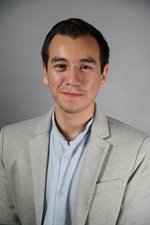
Adrian Vargas, a pre-doctoral student in the laboratory of Dr. Mitch O'Connell successfully defended his Qualifying Exam proposal entitled "Understanding guide-RNA design rules for efficient and specific Cas13 RNA-binding in human cells". Working on the recently described Type VI CRISPR-Cas system Adrian is investigating unique properties of the effector nuclease Cas13. His work has designed new approaches that will shed light on the mechanisms that govern optimal Cas13 RNA-binding, and potentially enhance its usability in human cells. Pursuing such goals not only will help complete our understanding of the gRNA requirements for on-target efficiency but more importantly, it will assist in uncovering what gRNA features contribute to off-target effects that could hinder the use of Cas13 as a specific RNA-targeting tool. The results will develop a more holistic biophysical model of Cas13 binding and cleavage activity. Congratulations Adrian on a job well done! You can read Adrian's thesis abstract below.
Title: Understanding guide-RNA design rules for efficient and specific Cas13 RNA-binding in human cells.
Abstract: Prokaryotic adaptive immune systems utilize Clustered Regularly Interspaced Short Palindromic Repeats (CRISPRs) and CRISPR Associated (Cas) proteins to target and cleave foreign genetic elements in an RNA-guided manner. The recently described Type VI CRISPR-Cas system contains a single effector ribonuclease, Cas13, that binds and processes a guide-RNA (gRNA), forming an RNA-guided RNA-targeting protein complex. Cas13 has been successfully engineered for potent RNA-knockdown in eukaryotic cells with minimal off-target effects, and other exciting applications described to date include utilizing a nuclease-dead Cas13 (dCas13) as a programmable RNA-binding protein for RNA imaging, RNA-splicing, RNA-detection or RNA-editing applications, among others.
However, the principles of guide-RNA selection for efficient and specific Cas13:gRNA RNA binding remain elusive. Previous work indicates that gRNA choice is important because not all gRNAs yield a robust RNA-targeting, and it is likely that there are different gRNA requirements for RNA-binding compared to RNA-cleavage applications. Furthermore, no predictive models exist for guide-RNA binding efficiency and specificity for Cas13 because no systematic screens have been carried out. Given that no transcriptome-wide measurements of Cas13-binding specificity have been attempted so far, it is unknown what the Cas13 off-target landscape is for human cells. Addressing this knowledge gap and quantitatively understanding the differences between binding and cleavage specificities is integral to the development of specific Cas13 RNA-binding applications.
In this project, I propose a series of approaches that will shed light on the mechanisms that govern optimal Cas13 RNA-binding, and potentially enhance its usability in human cells. Pursuing such goals not only will help complete our understanding of the gRNA requirements for on-target efficiency but more importantly, it will assist us in uncovering what gRNA features contribute to off-target effects that could hinder the use of Cas13 as a specific RNA-targeting tool, particularly for RNA-binding applications. In addition, these findings will be complemented by kinetic studies to dissect the biochemical components underlying Cas13 binding specificity to develop a more holistic biophysical model of Cas13 binding and cleavage activity. Consequently, we will generate a predictive model for Cas13 guide-RNA targeting specificity which will be complied into a comprehensive gRNA design tool tailored to different RNA-targeting applications for any RNA of choice. Finally, using the knowledge we generate and existing structural information, we will attempt to rationally engineer Cas13 and gRNA structure to enhance binding (and cleavage) specificities. Taken together, this work will bolster efforts to develop a range of RNA-targeting tools that can be readily used as research tools to address knowledge gaps in RNA biology, and as potential therapeutics.